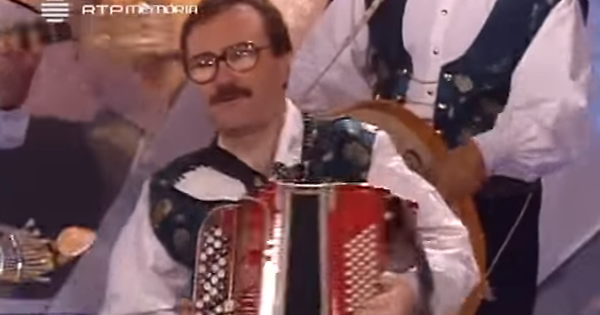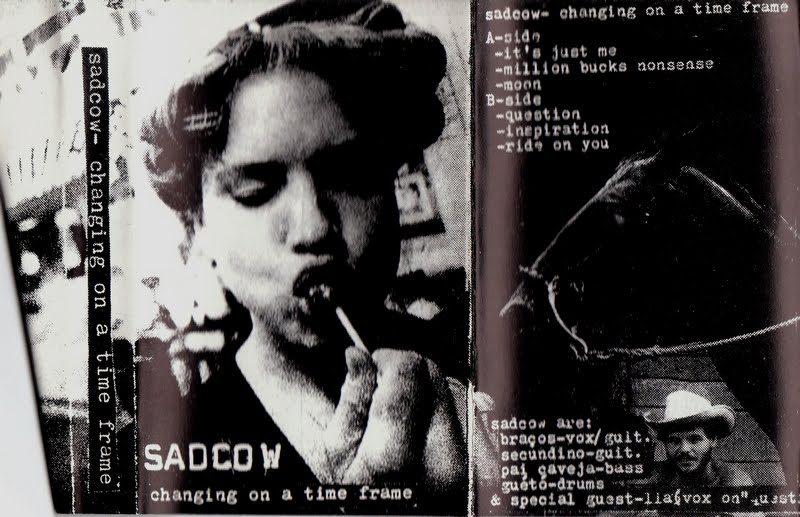Source: PGL.GAL
The group Maio Moço was founded in 1985 by Vítor Reino. The other elements of the group – Ana Rita Reino, Sérgio Contreiras and João Simões Lima – had also been members of the groups Almanaque and Ronda dos Quatro Caminhos. They were joined by Mário Gameiro.
In 1987, the album “Inda Canto Inda Danço” was released. The two sides of the LP were divided into “Danças de Terreiro” and “Danças de Salón”.
“Cantigas de Marear” was released in 1989. The theme of this record was the Sea and the Discoveries in the Traditional Portuguese Songbook. The album won the “Grande Prêmio do Disco” of Rádio Renascença. Rui Sardinha begins to collaborate regularly with the group.
In 1991 “Histórias de Portugal” was published, which included traditional themes from the historical period from D. Afonso Henriques to D. Sebastião. Rui Sequeira collaborates on this album, which once again received the “Grande Prêmio do Disco” from Rádio Renascença.
“Amores Perfeitos” from 1994 included nine poems by as many authors (from Camões to Fernando Pessoa) and a text of traditional origin that illustrates another facet of “Portuguese Love”.
The 1996 album “Estrada de Santiago” featured 13 songs that represented an imaginary journey through the musical tradition of all Portuguese provinces.
In 1998 the compilation “O Som e a História” was edited with 18 of the most representative themes of the group.
In 2002, Maio Moço returned to unpublished albums with the release of “CantoMaior”. The disc features old novels, dances, children’s or work songs, love songs or songs of a religious nature. The group used old and almost unknown traditional Portuguese instruments, such as the rajão, the viola dewire and the viola toeira. The oboe and a string quartet were also used.
Short Chronology
In summary, I present a simple chronology of the group, as unfortunately there is currently no good and comprehensive biography of such an important musical collective, which would be necessary to elaborate.
1985.-In the middle of this year, the musical group Maio Moço is created by Vítor Reino and his collaborators.
1987.-The group releases the album “Inda Canto Inda Danço”. The two sides of the LP were divided into “Terreiro Dances” and “Salon Dances”.
1989.-They record “Cantigas de Marear”, a work entirely dedicated to the Portuguese Discoveries and their importance in the Portuguese popular songbook, awarded the “Grand Prize of the Disc” by Radio Renascença and published in 26 countries on five continents.
1991.-The LP “Histórias de Portugal” comes to light, which includes a set of themes of traditional origin of enormous interest, covering the historical period from D. Afonso Henriques to D. Sebastião, and which once again deserved the “Grande Prêmio do Disco” by Rádio Renascença.
1994.-They record the album “Amores Perfeitos”, which includes a series of beautiful compositions about love and the popular flavor of some of the biggest names in Portuguese poetry, from Camões to Fernando Pessoa, which illustrates another facet of “Portuguese Love”.
1996.-They present the album “Estrada de Santiago”, in which listeners are invited to undertake a fascinating imaginary journey through the musical tradition of the thirteen Portuguese provinces.
1998.-The group publishes the compilation “O Som e a História”, a collection with 18 of the most representative themes of Maio Moço, recorded over 14 years, on five unpublished discs.
In 2002, Maio Moço returned to unpublished albums with the release of “Canto Maior”. The disc features old novels, dances, children’s or work songs, love songs or songs of a religious nature. The group used old and almost unknown traditional Portuguese instruments, such as the rajão, the viola dewire and the viola toeira. The oboe and a string quartet were also used.
Maio Moço imposed himself on the arduous but exciting task of fighting for the recovery and revitalization of the vast and valuable Portuguese musical tradition, creating a new music with traditional roots in which the rich and fascinating sounds so characteristic of our old popular instruments “marry” with the modern features of today’s technology. The most beautiful pieces by the group to listen to are the “Quadras à prova popular”.
The Maio Moço Group is composed of the following musicians and singers:
Maio-moco-capa-disco-inda-canto-inda-danco-1987 1.-Ana Rita Reino (Mandolin, banjo, cavaquinho, adufe, reeds, palms, tambourine, sticks and voice).
2.-João Simões Lima (Amarantina viola, bass drum, popular box, darbuka, frets, palms, sticks, reque-reque, snare drum and voice).
3.-Mário Gameiro (Wire viola, braguesa viola, campaniça viola, classic viola, earth viola, toeira viola, palms, sticks and voice).
4.-Vítor Reino (Accordion, concertina, flutes, bagpipes, synthesizers, clapping, sticks and voice). Main founder of the collective and deceased in Almada last May of this year 2020.
5.-Sérgio Contreiras (Castanets, sticks, palms, choirs and voice).
6.-Rui Sá Sequeira (Acoustic guitar, sticks, clapping and choirs).












Maio Moço, una joya cultural que celebra las raíces y tradiciones, nos transporta con su esencia única y su profunda conexión con la identidad caboverdiana.
A skilled vocalist can inspire, heal, and uplift others.